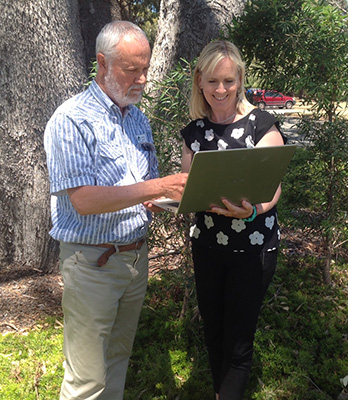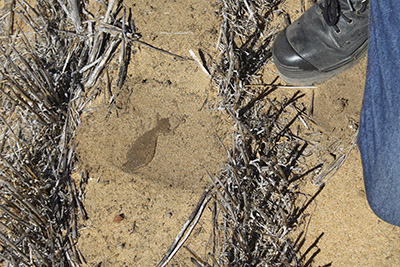Paddock Practices: Testing time for soil amendment economic tool
Paddock Practices: Testing time for soil amendment economic tool
Author: Melissa Williams | Date: 25 May 2018
Key points
- Modelling indicates soil constraints cost WA growers on average $330 per hectare in lost grain production
- This costs the State’s grain industry about $4.3 billion/year
- The average cost of soil amendment across grain growing regions in WA is about $41/ha
- The benefit is about $124/ha/year (annualised value)
- This has a benefit:cost ratio of 3:1 and a net benefit of about $83/ha/year.
Allocating part of the budget to soil amelioration practices has significant benefits for farm businesses across the Western Australian grainbelt.

The value of soil amelioration has been estimated to be worth an average of about $125 per hectare per year, depending on location, soil type and crop type.
This season, WA growers and advisers are encouraged to test a new decision-making tool that aims to help them prioritise the spend on amelioration tactics to address soil constraints to get the best ‘bang for their buck’.
With a limited budget and often multiple soil constraints in different areas of a farm, the Ranking Options for Soil Amelioration (ROSA) model is able to provide a ranking of the return on investment from a range of strategies.
ROSA has been developed with investments through GRDC’s Soil Constraints West group of projects and the Department of Primary Industries and Regional Development (DPIRD).
It draws on key data from the 2016 DPIRD report Economic analysis of the impacts and management of subsoil constraints.
Feedback from growers and advisers interested in testing the ROSA model this year is needed by the end of May so it can be fine-tuned and updated for expected release in mid-2018.
To receive a copy of ROSA, contact DPIRD senior development officer Jeremy Lemon at jeremy.lemon@dpird.wa.gov.au.
What can ROSA test?
DPIRD economist and ROSA project leader, Elizabeth Petersen, says the tool provides a ranking of the cost-effectiveness of a range of common soil amendment options to address one or more soil constraints on a property.

It considers short and long-term budget implications of the costs and benefits at a paddock or farm scale - for single amendment options and combinations.
These are accrued at different points in time across a 10-year period and calculations are made about likely returns for each dollar spent.
ROSA includes scenarios for the most common WA soil constraints of:
- Topsoil and subsoil acidity
- Water repellence
- Subsoil compaction
- Soil structure decline.
Soil amendment options that can be analysed in the tool include:

- Claying water repellent soils
- Deep ripping (below a depth of 40 centimetres)
- Adding gypsum to address structural decline in sodic soils
- Liming to address topsoil and subsoil acidity
- Soil mixing (shallower than 40cm) to address water repellence and compaction
- Use of wetting agents for water repellent soils.
Who will the ROSA model suit?
Previous research through the GRDC’s Soil Constraints West group of projects has identified that most of WA’s wheat-growing area has one or more soil constraints and many growers could benefit from analysing the economics of implementing options to address these.
The potential yield gains for a range of soil types by addressing soil constraints – as found using the ROSA model – is shown in Figure 1.
Figure 1: Indicative potential yield responses (tonnes/ha) to soil amelioration by crop type and Western Australian agricultural soil zone.
Source: Estimates from Elizabeth Petersen, DPIRD.
What data do I need for a ROSA analysis?
ROSA can be used with very little input requirements and an analysis typically takes about half an hour. Farm data needed includes:
- Location/agricultural soil zone
- Soil type
- A budget for soil amendments
- Rotation used
- Current and potential expected grain yields
- Soil properties (ranked as low, medium or high - except for soil pH).
What will the model provide me?
ROSA is designed to help growers get the biggest bang for their buck when prioritising tactics to help ameliorate one or multiple soil constraints.
It compares likely profit from using one or more tactics for a particular soil type or zone and ranks these to provide the most cost effective on-farm investment opportunities.
Dr Petersen says the return to investment in ROSA modelling is based on comparing a Benefit Cost Ratio (BCR) for each soil amelioration option or combination. This is a ratio of benefits over costs that have been discounted over time and represents the dollar return for each dollar spent.
A BCR higher than one indicates a positive return to investment and the higher the BCR, the better the return to investment.
Default grain yield responses and costs contained in ROSA come from data gathered from WA growers, advisers and past research. These can be adjusted by growers and advisers using ROSA for their specific soil properties (by soil type) to reflect local conditions.
Estimating the cost of doing nothing
Dr Petersen says ROSA can estimate the value of lost grain production from soil constraints by calculating the gap (for each crop type) between actual yield (in the presence of soil constraints) and potential yield (in the absence of soil constraints considered in the model).
This yield gap is multiplied by farm-gate price and the estimated average area sown to each crop type by agricultural soil zone.
Farm-gate prices in ROSA are based on five-year averages rounded to the nearest $10 and then discounted $30/ha for cartage, grading and levies.
Dr Petersen says from this database, ROSA estimates WA croppers lose $4.3 billion each year from soil constraints - dominated by losses in the central and northern grainbelt.
She says the weighted average loss from soil constraints across all WA crop areas is about $330/ha and the south coast has the highest weighted average loss at about $490/ha. This is due to the higher yield potential in this zone (on the back of more rainfall). A break-down of estimated losses by region is outlined in Table 1.
| Ag Soil Zone | Value of losses due to soil constraints ($billion/year) | % loss by Ag Soil Zone | Weighted average loss ($/ha) |
|---|---|---|---|
| Mid west | 0.3 | 7 | 250 |
| Mullewa to Morawa | 0.2 | 5 | 300 |
| West midlands | 0.1 | 3 | 200 |
| Central-northern grainbelt | 1.3 | 31 | 320 |
| East Moora to Kojonup | 0.7 | 15 | 400 |
| Southern grainbelt | 0.7 | 17 | 310 |
| Stirlings to Ravensthorpe | 0.2 | 5 | 450 |
| South coast | 0.5 | 12 | 490 |
| Salmon Gums (mallee) | 0.2 | 4 | 280 |
| Total | 4.3 | 100 | 330 (weighted average) |
Source: Elizabeth Petersen, DPIRD, estimates.
Benefits of addressing soil amelioration
Dr Petersen estimates it will cost about $41/ha for WA growers to use the most cost-effective combination of soil amelioration tactics to address constraints (where there are only one or two constraints).
She says the benefit is estimated by ROSA at $124/ha/year on average (based on annualised values).
This has a benefit-to-cost ratio of 3:1 and a net benefit of $83/ha/year. This indicates that for every $1 spent on soil amelioration, a grower receives about $3 in return – worth a net $1billion/year across the grain-growing areas of the State.
Response gains and losses due to soil constraints are represented by ROSA as a weighted average for each crop type and are shown in Figure 2.
Figure 3: Estimated indicative weighted average value of amelioration of soil constraints by crop type and Ag Soil Zone ($/ha) (within Zones, losses due to constraints are a weighted average for each crop type and response to amelioration by area) Source: ROSA modelling results

What comes next?
GRDC’s Soil Constraints West group of projects is continuing to assess the economics of managing soil constraints in WA.
Dr Petersen says grower and adviser feedback from ROSA analyses conducted during May will be used to refine the model, with an updated version expected to be available from mid-2018.
She says in 2018 there will be more ROSA modelling research into the economic feasibility of dealing with multiple subsoil constraints and combinations of amendment strategies.
Dr Petersen says seasonal impacts and management strategies for each soil constraint will also be investigated, rather than assuming an average season.
She says the goal is to provide industry with a practical and valuable tool to help boost confidence on-farm in adopting soil-amelioration strategies and assist in managing farm businesses through variable seasons.
GRDC Project Codes: DAW00244; DAW00243; DAW00242; DAW00236; DAW00252
More information
Elizabeth Petersen, DPIRD
0404 077 194,
Liz.Petersen@dpird.wa.gov.au
Useful resources
GRDC Soil Constraints - West website and newsletters
DPIRD ROSA information and links
GRDC 2018 Grains Research Updates papers, including Elizabeth Petersen
GRDC Project Code: DAW1407-001RTX, DAW1407-004RTX, DAW1407-002RTX, DAW1401-001RTX, DAW1504-003RTX,

